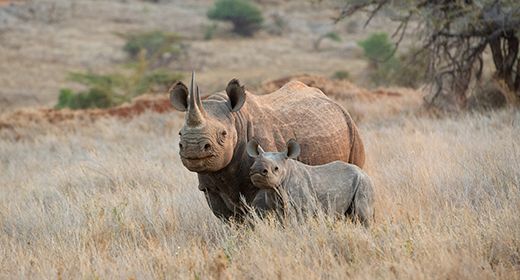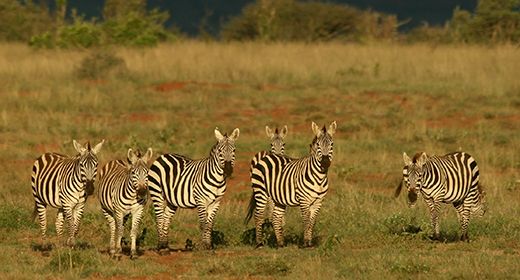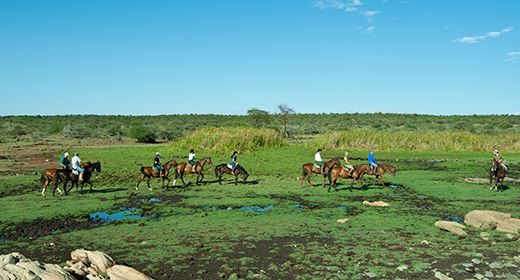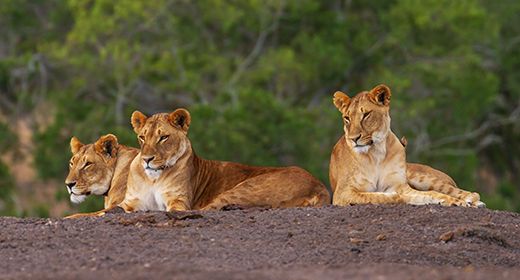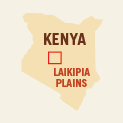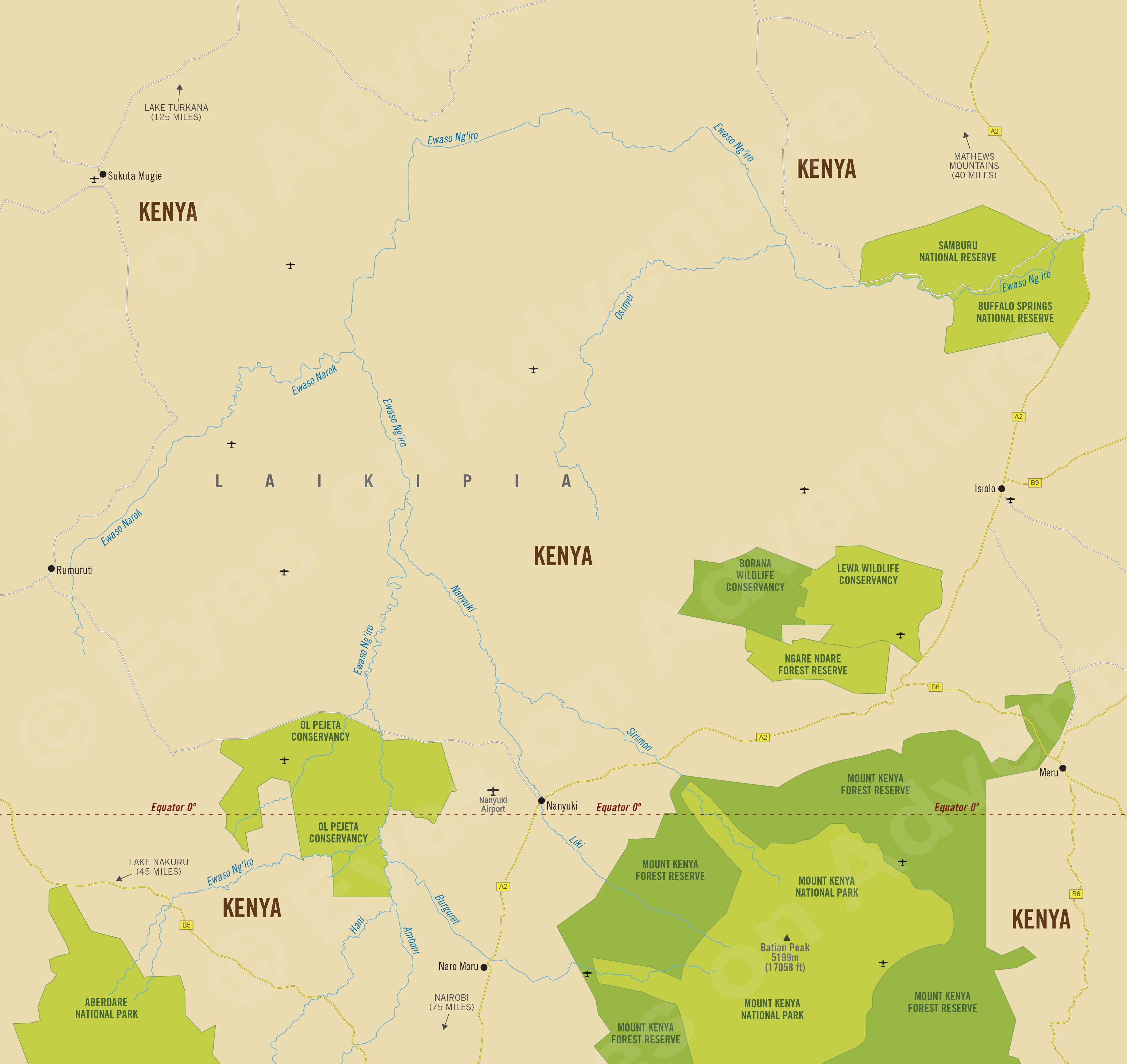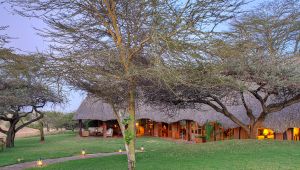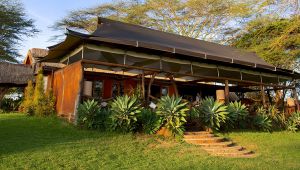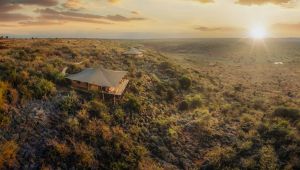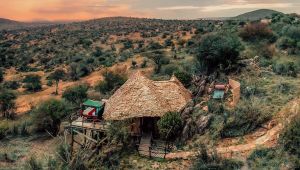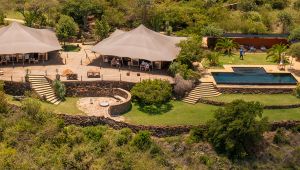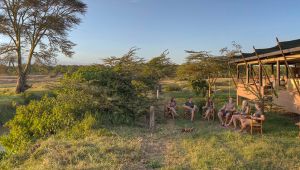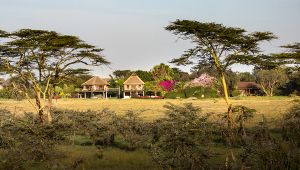Laikipia
(incl. Lewa, Ol Pejeta, Borana, Loisaba, Sosian, Mugie)
Region Links: Amboseli & Chyulu Hills, East Coast Kenya, Great Migration, Laikipia, Masai Mara, Nairobi, Rift Valley & Central Highlands, Samburu, Tsavo
Highlights
- Multiple conservancies combining ranching with tourism and wildlife protection
- Kenya's most diverse region for wildlife species
- Exclusive lodges offering superb wildlife viewing and conservation
- The experiences offered are different from Kenya's other reserves
EOA Recommends: Lewa Safari Camp, Sanctuary Tambarare, Segera Retreat, Sosian Lodge, The Sanctuary at Ol Lentille
The Laikipia plateau lies northwest from Mount Kenya and covers over 3 700 square miles (9 500 sq kms). Laikipia includes a patchwork of wildlife conservancies and numerous working ranches that coexist well with native wildlife, creating some of Kenya's best conservation successes.
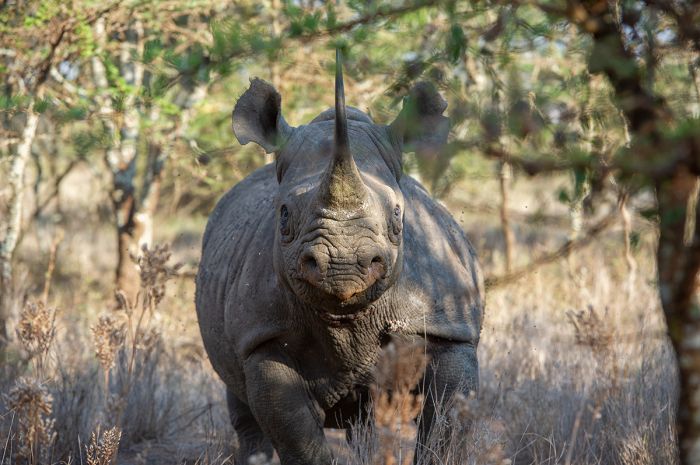
Black rhino at Lewa Conservancy (Copyright © James Weis).
Laikipia is a transitional land between the lush central Kenya highlands / Aberdare Mountains of the eastern Rift Valley in the south and the arid, desert-like Samburu lands in the north. There are no national parks here, but the private conservancies and private and community-run group ranches make it one of the best places in Kenya to see wildlife.
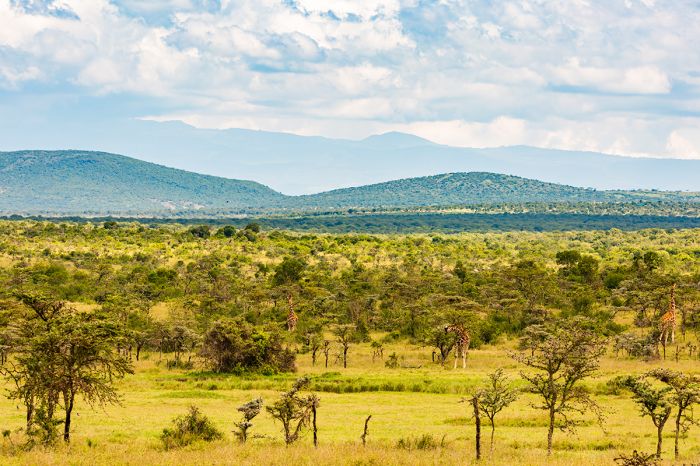
A herd of giraffe on the Laikipia Plateau, Kenya.
Lewa, Borana and Ol Pejeta conservancies are well-run wildlife destinations, each offering good safari camps and excellent game viewing. There are also private ranches that now serve as safari lodges. The wildlife in Laikipia is diverse and abundant, especially in the refuges. The region offers plenty of plains game, plus good populations of black and white rhinos, Grevy's zebras, cheetahs, lions, leopards and wild dogs.
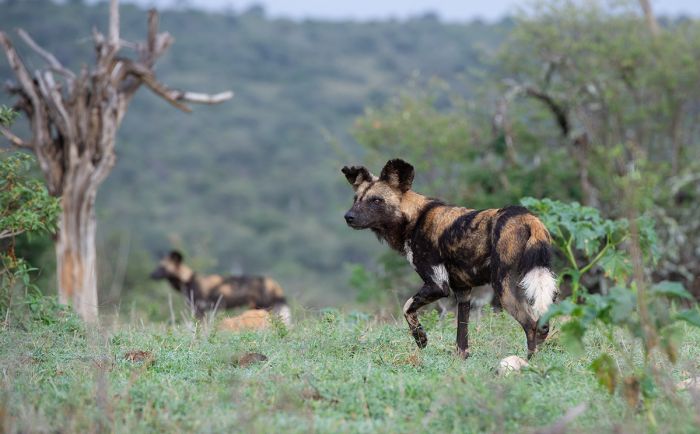
African wild dogs at Sosian Ranch (Copyright © James Weis).
For those wanting to escape the crowds and see a wide variety of wildlife, the conservancies and private ranches in Laikipia are a very good option. It's also a great add-on to a safari in the Masai Mara.
Read More...
Borana, Laikipia Region, Lewa, Loisaba Conservancy, Mugie Ranch, Ngare Ndare Forest, North Laikipia, Ol Pejeta, Sosian Ranch
Laikipia region
Laikipia was and still is, largely a livestock region dating back to the colonial era. Even so, the area has Kenya's highest diversity of wildlife species due to its location as a transitional zone between the lush south and the arid far north.
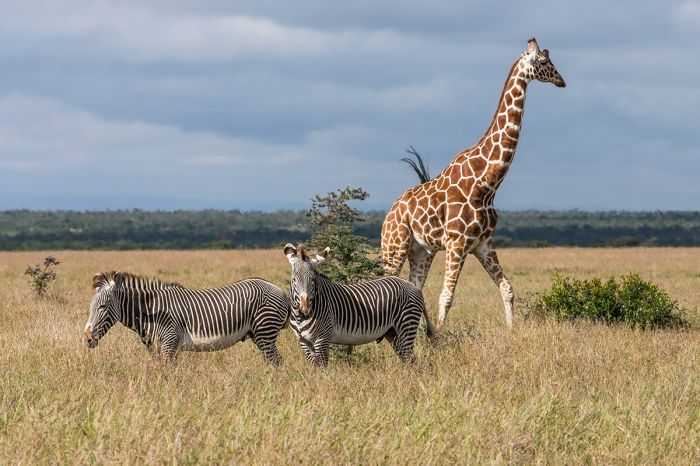
Grevy's zebras and reticulated giraffe in Laikipia (Copyright © Segera).
Laikipia's protected areas consist solely of conservancies and group-ranches and its wildlife and land is closely managed, even more so than Kenya's national parks. Research and conservation are the main focus in this region and you may see predators with a radio collar used for monitoring the animals. Safari visitors are able to assist with radio-tracking at some properties.
Local private and group ranches operate as dual-use properties, with livestock and safari tourism coexisting hand-in-hand. These ranches typically have a colonial feel and include ranch activities, game drives, night drives, walking safaris and sometimes horseback safaris.
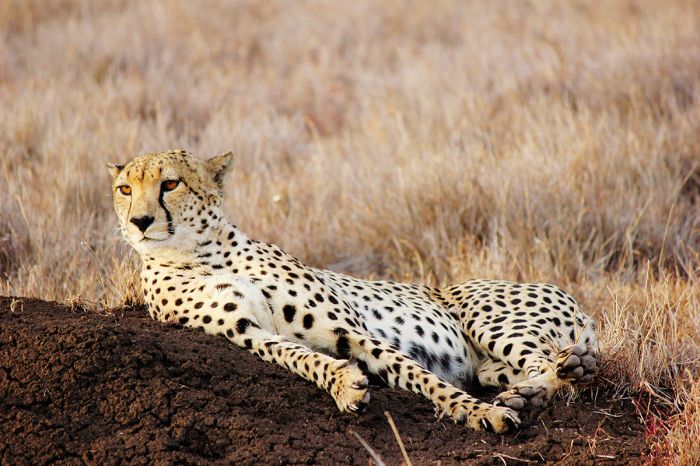
Cheetah in the Lewa Conservancy.
The Laikipia Wildlife Foundation (LWF), a non-profit organization formed in 1992, oversees the area as a whole. Membership in LWF includes all private ranches and conservancies in the region, as well as the community groups representing the diverse local tribes such as the Maasai, Kikuyu, Samburu, and Pokot.
The three main wildlife conservancies in Laikipia are Lewa, Borana and Ol Pejeta. All offer top-notch safaris and excellent accommodation. Visitors are able to see the superb wildlife and learn about their conservation initiatives.
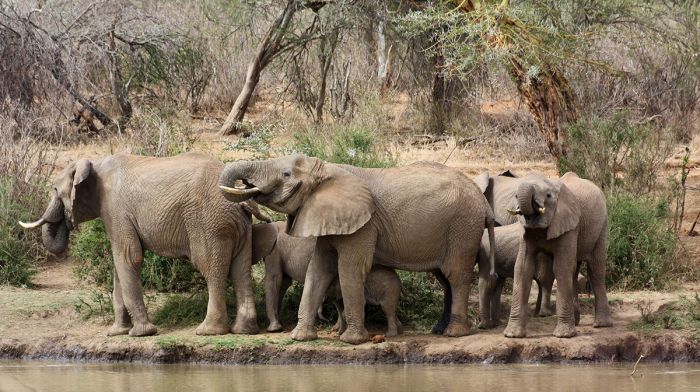
Elephants drinking at the Ewaso Ng'iro River, Laikipia.
Ol Pejeta conservancy
The Ol Pejeta Conservancy, which covers 141 square miles (365 sq kms), is a working cattle ranch that has been converted to a dual-use property that protects wildlife while still maintaining cattle farming. The conservancy is now owned by Fauna and Flora International and is run as a non-profit.
Ol Pejeta is primarily grassland with some acacia scrub and is well watered via boreholes, which provides excellent habitat for an abundance of wildlife. The perimeter of the property is surrounded by an electric fence and rangers patrol the property every day to watch over the land and wildlife inside.
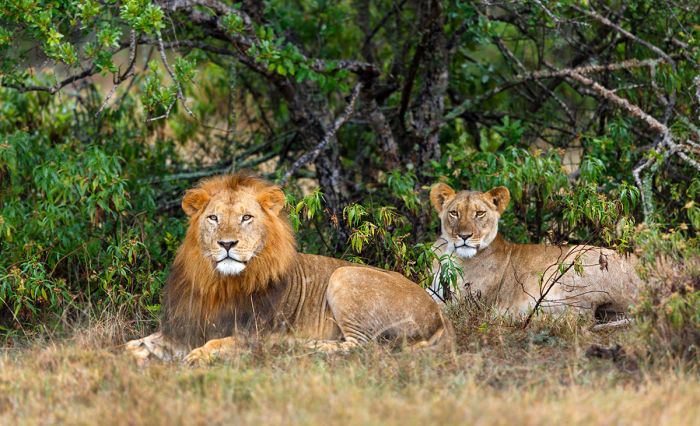
Lions in the Ol Pejeta Conservancy.
Wildlife management is combined with the world's largest herd of Boran cattle, a well-known beef breed in Africa. The cattle are maintained and protected from predators by placing them inside mobile 'bomas' at night. The management of cattle and wildlife together at Ol Pejeta is considered a model conservation effort, which provides tourism and beef revenue, plus cattle stock improvement for the local communities.
The eastern side of Ol Pejeta was formerly the Sweetwaters Rhino Sanctuary, which gained fame for a tame black rhino bull named 'Morani' that could be hand-fed by visitors. Morani died in 2008, but the reserve now boasts good numbers of both black and white rhinos.
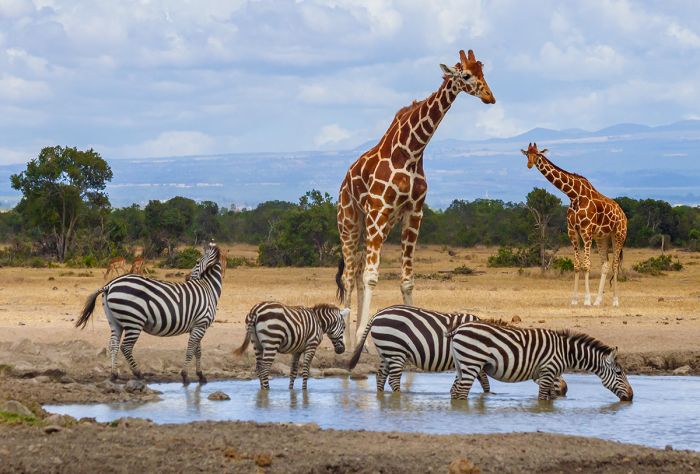
Zebras and giraffes at Ol Pejeta Conservancy.
Ol Pejeta also has a fenced chimpanzee sanctuary, which houses chimps from the Jane Goodall Institute in Burundi and other orphans rescued from the bush-meat trade throughout other parts of Africa. This chimp haven has two troops, one on either side of the Ewaso Ng'iro river and a boat ride to see the sanctuary is a popular activity.
Plains game is abundant at Ol Pejeta, with commonly seen species including buffalo, elephant, reticulated giraffe, Jackson's hartebeest, gerenuk antelope, Beisa Oryx, Grevy's zebra, blue wildebeest, and hippo.
Predators include leopard, lion, cheetah, spotted hyena, African wild dog, black-backed jackal, serval, bat-eared fox, caracal, and others. Birding at Ol Pejeta is excellent, with a list that tops 300 species.
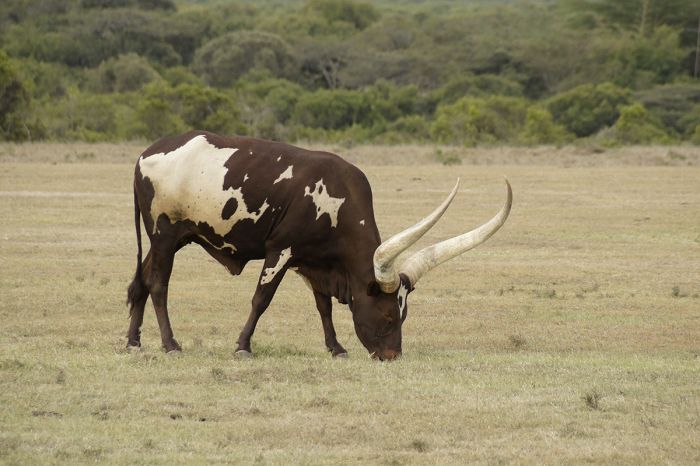
Domestic cattle herds exist alongside wildlife at Ol Pejeta.
Activities at Ol Pejeta include game drives (both day and night), guided walking safaris, horse riding, cycling, and wildlife radio-tracking with researchers.
Access to Ol Pejeta is via Nairobi (4-hour drive) or a scheduled flight from Nairobi's to Nanyuki (75 minutes / outside the conservancy / 30- to 45-minute drive to the Ol Pejeta gate) or to Kamok Airstrip (75 minutes / inside the conservancy). Charter flights to Nanyuki from anywhere in Kenya are also an option.
Lewa conservancy
The Lewa Wildlife Conservancy, which covers 96 square miles (250 sq kms), is a non-profit wildlife conservation refuge originally formed in 1983 as the Ngare Sergoi Rhino Sanctuary. The sanctuary was established to save the last of northern Kenya's critically endangered black rhinos. Ngare Sergoi became the Lewa Wildlife Sanctuary in 1995.
Before it became a protected sanctuary, the land was a cattle ranch, but today Lewa is one of Laikipia's finest reserves. The conservancy is completely fenced and very well managed. Lewa's mission is to work closely with the surrounding communities to ensure that they, as well as the wildlife, benefit from its conservation efforts. Lewa is a member of the Northern Ranglelands Trust, which includes local communities as its partners.
Lewa, together with Borana, which lies directly to the west, protect around 14% of Kenya's rhino population and 11% of its remaining Grevy's zebras. The combined reserves are one of only three reserves which have a stable and increasing black rhino population.
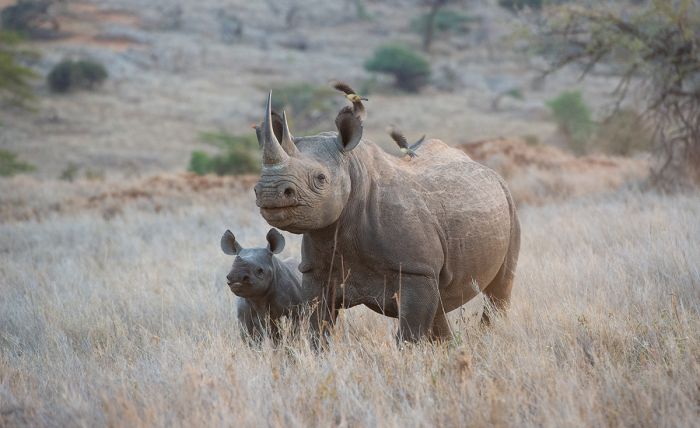
White rhino and calf at Lewa (Copyright © James Weis).
Lewa is primarily grassland with interspersed hills, scrub bush, and wooded valleys, providing excellent habitat for its healthy populations of both black and white rhino. Lewa is also home to around 350 Grevy's zebra, the largest single population of this species in the world. The Lewa swamp boasts a localized population of sitatunga antelope, originally relocated from the Saiwa swampland during the 1980's.
In addition to the endangered species protected at Lewa, the general game viewing is excellent, with all of Africa's Big Five found here. Elephants are found in good numbers, as well as reticulated giraffe, buffalo, blue wildebeest, Beisa oryx, eland, impala, Grant's gazelle, and gerenuk.
Lewa also boasts a host of predators including lion, leopard, cheetah, spotted hyena, black-backed jackal, and sometimes African wild dog. Hippos are found in the Lewa swamp.
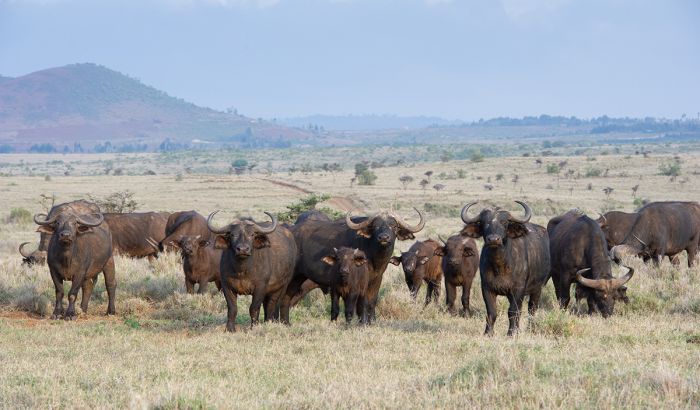
Buffalos at Lewa Conservancy (Copyright © James Weis).
Borana Conservancy
Adjoining Lewa is the Borana Conservancy. Like most of the wildlife initiatives in Laikipia, Borana began as a cattle ranch and, like Ol Pejeta, is today run as a dual-purpose operation, merging beef cattle farming with wildlife conservation and tourism.
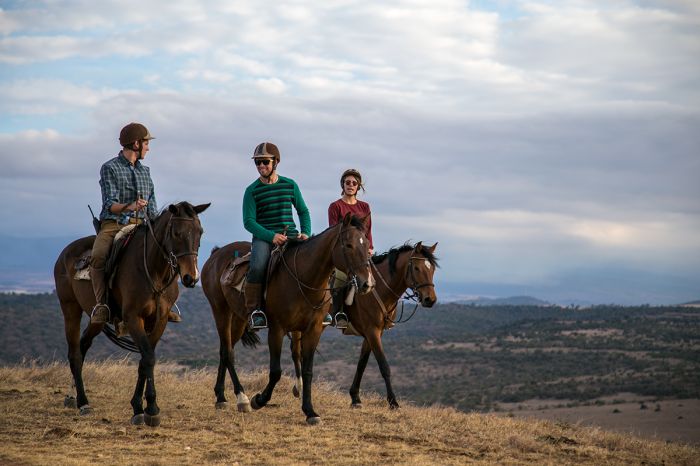
Horseback riding safari in the Borana Conservancy.
The fence dividing Lewa from Borana was removed in 2013, thus creating a combined 147-square-mile (380-sq-km) sanctuary for wildlife. Borana maintains a herd of 2 000+ Borana cattle, as well as a wool and leather production manufacture, both employing members from local communities.
Borana monitors multiple species via radio collar and has a full-time anti-poaching team to protect its rhinos and other wildlife. Lions, elephants, wild dogs, hyenas and cheetahs are only some of the species being researched and protected at Borana.
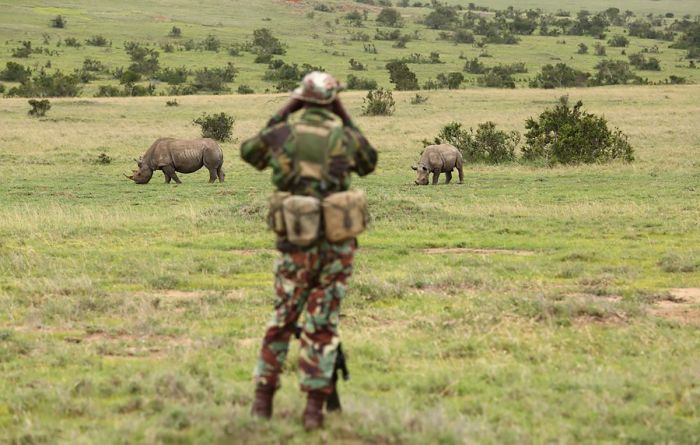
Monitoring white rhinos at Borana Conservancy.
Visitors to Borana are able to participate in wildlife management activities, but the big activity here is horse riding on the reserve. Riders are able to get very close to wildlife on horseback, as the animals are not afraid of the horses. Game drives, safari walks and mountain biking are also on offer.
Ngare Ndare Forest Reserve
Directly adjoining the southern border of Lewa Wildlife Conservancy is the Ngare Ndere Forest Reserve. Ngare Ndare is an indigenous forest with 200-year-old trees and and a place of pristine beauty. The lush forest, which is continuing to be enriched by annual tree planting, protects a vital and age-old corridor for elephants that move south to Mount Kenya and north to Lewa and the Northern Rangelands.
Ngare Ndere has an unique attraction for Kenya, a canopy walkway suspended 100 feet (30 meters) above the forest floor and traversing through the trees for 1 480 feet (450 meters). The suspension walk ends on a viewing platform, where one can hope to see elephants gathered in the swamp below.
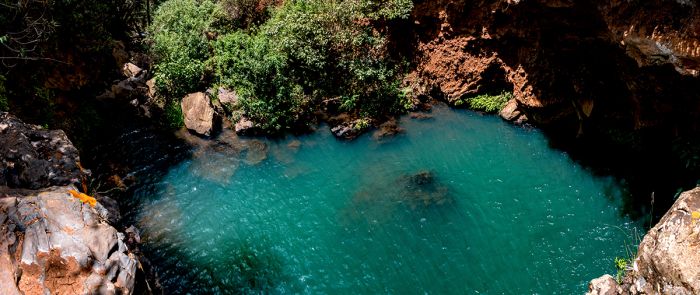
One of Ngare Ndare's lovely natural swimming pools beneath a waterfall.
Visitors can self-drive through the park or hire a ranger to accompany them (recommended). There are some beautiful waterfalls in the reserve and swimming in the pool beneath some of them is a highlight. Walking in the forest is allowed only with a ranger (please book in advance).
Besides elephants, which are commonly seen in Ngare Ndare, wildlife that one may expect to see includes buffalo, baboon, various monkeys, and bushbuck. Ngare Nadare is also wonderful for birding. Don't come to the reserve specifically for wildlife, but more the experience; those looking for better wildlife nearby are encouraged to head north to the adjoining reserves at Lewa or Borana.
Accommodation is at two basic camp sites, both of which have running water and toilets.
The name of the reserve is derived from the Maa language (which isspoken by the Maasai people) and means 'a watering place for goats'.
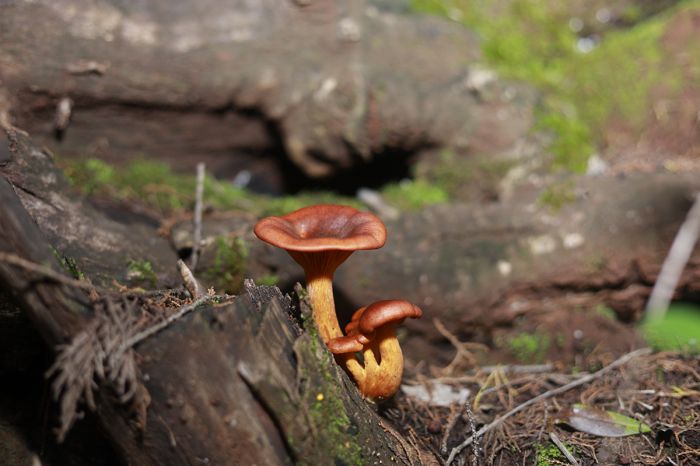
Forest mushroom in the Ngare Ndare Forest Reserve, Kenya.
Sosian ranch
Located along the Ewaso Narok river is Sosian Lodge, a 40-square-mile (100-sq-km) property, offering ranch activities, horse riding safaris, archery, fishing, 'river tubing', and game drives with some of the best wildlife viewing in all of Laikipia. All the large mammals are here (except rhinos), plus great opportunities to see Africa wild dogs, which are researched and monitored via radio tracking by the ranch. The beautifully restored, Colonial-style main house is surrounded by comfortable cottages.
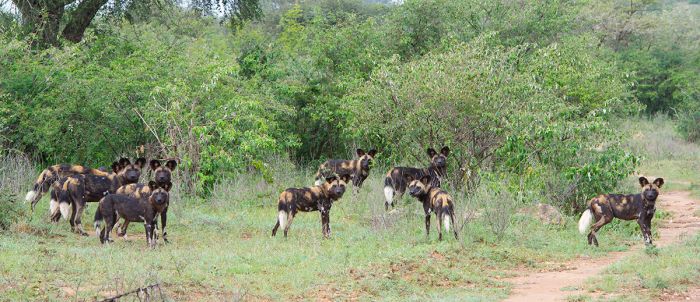
African wild dogs at Sosian Ranch (Copyright © James Weis).
NorthERN Laikipia
Laikipia's far north is a remote and pristine destination and there are numerous ranches here that offer tourist camps and wildlife viewing along the Ewaso Ng'iro gorge. The landscape here is a thicker bush than that in the south and the focus in most of the far north lodges is on walking rather than vehicle game viewing, making it ideal for an "end of a safari" itinerary.
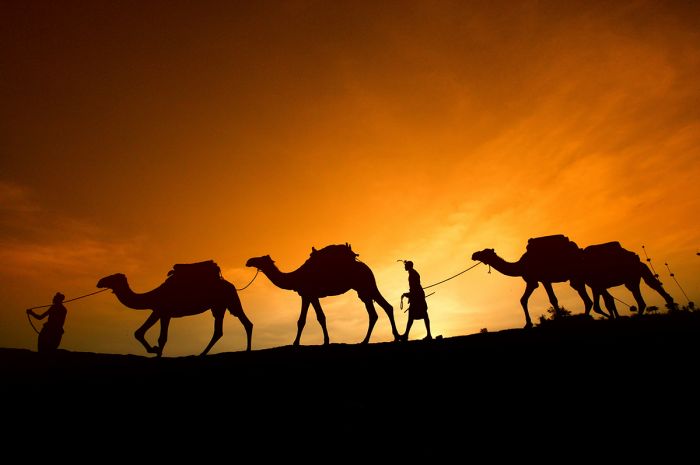
Camels at Sabuk, northern Laikipia.
Loisaba Conservancy
Loisaba is a 89-square-mile (231-sq-km) working cattle ranch and wildlife sanctuary lying west of the Ewaso Ng'iro River in Northern Laikipia. The ranch provides a critical link connecting Laikipia to the Samburu region to the east, helping to ensure that a well-used wildlife (particularly elephants) and livestock movement corridor is protected.
The ranch has a herd of over 2 000 Boran cattle. Loisaba offers diverse activities including walking safaris, horseback safaris, tracking wildlife, mountain biking, camel rides, quad-biking, ballooning, and river rafting. An elevated "star bed" accommodation offers guests the option to sleep under the stars.
The land was purchased by the Ancilotto family in the 1970s, who managed it as a low-impact cattle ranch and tourist destination with a vision of protecting the land as a wilderness for the native wildlife and future generations.
In 1997, the land was leased to a group of Kenyans and an American investor, who created the Loisaba brand and managed it as a successful ranching, conservation, and tourism business until 2014, when the land was transferred to the Loisaba Community Trust. The transfer was facilitated by The Nature Conservancy, Space for Giants, and generous donors. Today, The Loisaba Community Trust continues to ensure that Loisaba remains a world-class conservation and ecotourism destination, as well as a hub for wildlife research.
Loisaba's stated mission is to protect and enhance critical wildlife diversity, abundance, and habitat in the Loisaba landscape, while concurrently supporting sustainable livestock production and improving the lives of neighboring communities. Both tourism and livestock bring revenue to the land and offer over 300 jobs to local communities.
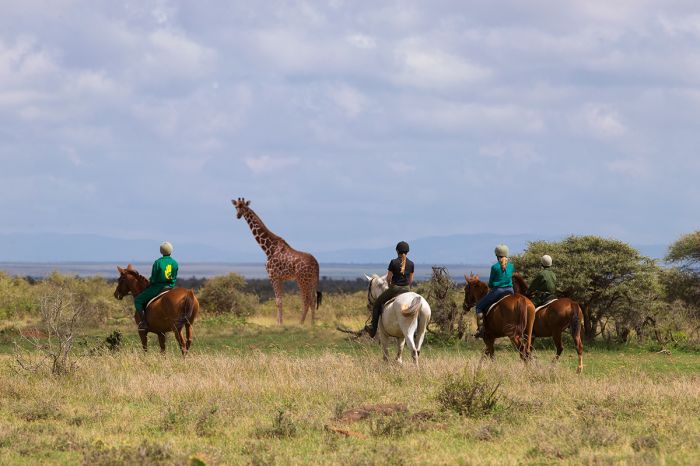
Horseback safari at Loisaba - Laikipia, Kenya (Copyright © Loisaba).
Mugie Ranch
In Laikipia's far northwest is the Mugie Ranch (77 sq miles/220 sq kms), offering more wildlife and cattle in coexistence. Activities at both include camel riding, mountain biking, hot-air balloon rides, river rafting, and walking safaris. The Mugie Rhino Sanctuary covers half of the ranch. The wildlife here is somewhat sparse, but includes good opportunities to see elephant, leopard, greater kudu and a full host of drylands species.
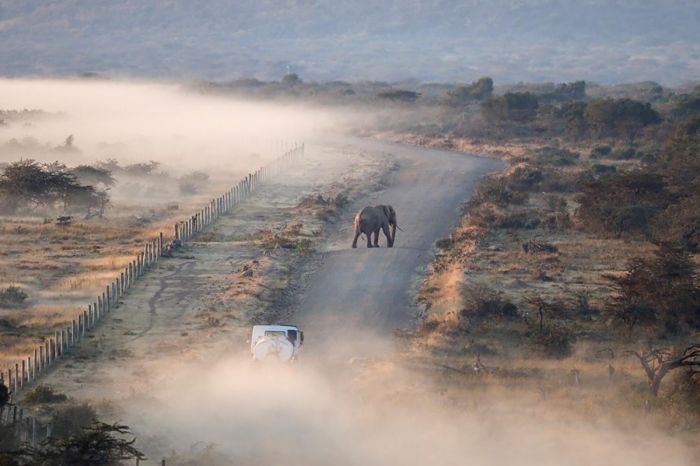
An elephant walking on Mugie Ranch in northern Laikipia (Copyright © Mugie Ranch).
Read More...
Borana, Laikipia Region, Lewa, Loisaba Ranch, Mugie Ranch, Ngare Ndare Forest, North Laikipia, Ol Pejeta, Sosian Ranch
Great Good Fair Poor
- Jan
- Feb
- Mar
- Apr
- May
- Jun
- Jul
- Aug
- Sep
- Oct
- Nov
- Dec
When to Visit
Laikipia is generally a year-round destination, but the best time to visit is during the relatively dry season from June thru September. As with most of Kenya, the short rains on the Laikipia Plateau occur for about a month sometime between mid-October and mid-December. The longer and heavier rains occur from March thru May.
No period is completely without rain, but the wettest months are April, May, and November and the driest months are January, February, and September.
Temperatures are also fairly constant year-round, as the equator is located very close (just to the south). Temperatures during the day average 77-83°F (25-28°C), but to cools down quite a bit overnight and dressing in layers is a must for the morning activity.
The Laikipia reserves do not receive large numbers of tourists like the Masai Mara, but Lewa and Ol Pejeta can get busy during the high season. Some lodges are closed in April, May and November due to the rains.
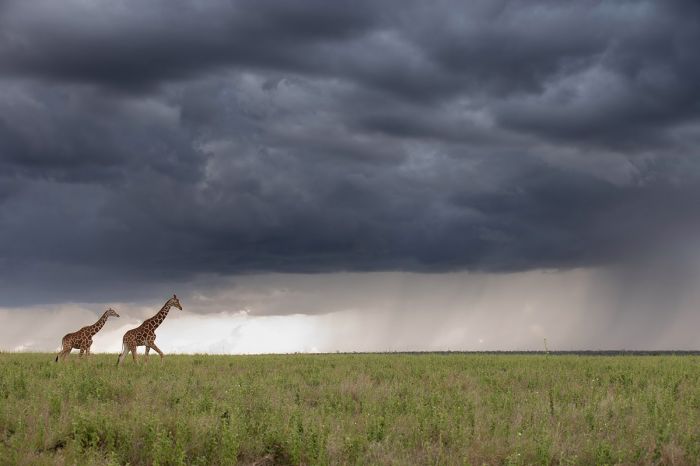
Giraffes and rains over Laikipia grassland (Copyright © Segera).
Winter
June through September are the winter month and relatively dry, but rain is still quite possible. June and July experience static temperatures, averaging 77-79°F (25-26°C) during the day and dropping to around 48-50°F (9-10°C) overnight.
Temperatures increase slightly in August and September, averaging 80-82°F (26-28°C) during the day and 50-52°F (10-11°C) during the night. Some rains do fall in August and September.
Most days during the winter are clear to partly cloudy.
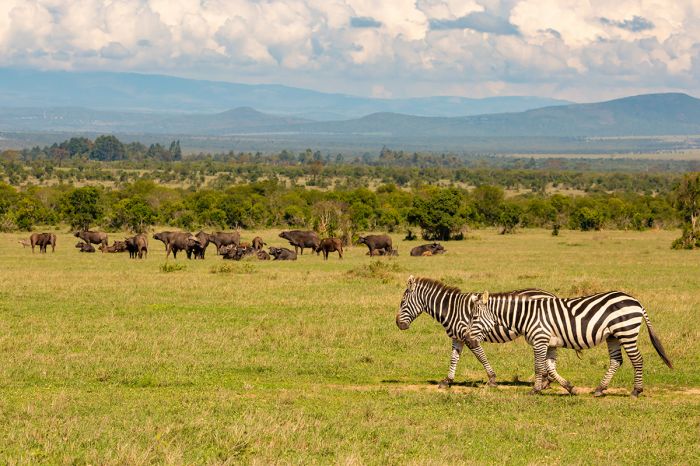
Buffalos and zebras at Ol Pejeta Conservancy, Laikipia.
Summer
The runner months are October through May, which includes the short rains, which fall for about a month between October and December and the longer, heavier rains from March through May. April is the rainiest month.
October and November experience daytime temperatures averaging 74-76°F (23-24°C) and overnight lows of 54-55°F (12-13°C).
Mid-December through February is a period of low rainfall, which separates the previous short rains from the coming long rains. There are still some days with rain. Daytime temperatures reach 76-79°F (24-26°C) and overnight lows are 52-54°F (11-12°C). Days can be clear or overcast.
March through May are the long rain months, with April being the rainiest month. This is a period to avoid, as the rains can be heavy and persistent, although all-day rains are uncommon. The road conditions can become muddy and slippery. Daytime temperatures average 78-81°F (25-27°C) and overnights average a comfortable 54-55°F (12-13°C).
Showing 1–7 of 7 results
Small and intimate camp with just 5 guest cottages. The Lewa Conservancy has long been at the forefront of rhino conservation efforts and offers a diversity of other wildlife. Game drives, guided walks, horse riding, camel riding.…
Located in the Lewa Conservancy, which has long been at the forefront of rhino conservation efforts. See diverse wildlife on safari drives, guided walks, and horseback. The camp is 100%-owned by the conservancy.…
Luxury tented camp in the vast Loisaba Conservancy in Northern Laikipia. The camp offers panoramic views from atop a high ridge. Good wildlife viewing and diverse activities including game drives, mountain biking, walking, horse and camel riding, visits to the local Samburu.…
Unique guest rooms offer roll-out beds to sleep under the stars. Good wildlife viewing and diverse activities including game drives, mountain biking, walking, horse and camel riding, visits to the local Samburu.…
Contemporary and stylish camp in the vast Loisaba Conservancy in Northern Laikipia. The camp offers panoramic views from atop a high escarpment.…
A traditional East African bush camp in a renowned wildlife conservancy protecting endangered species. Diverse and abundant wildlife. Game drive, horse riding, lion tracking, cycling, culture, and more.…




